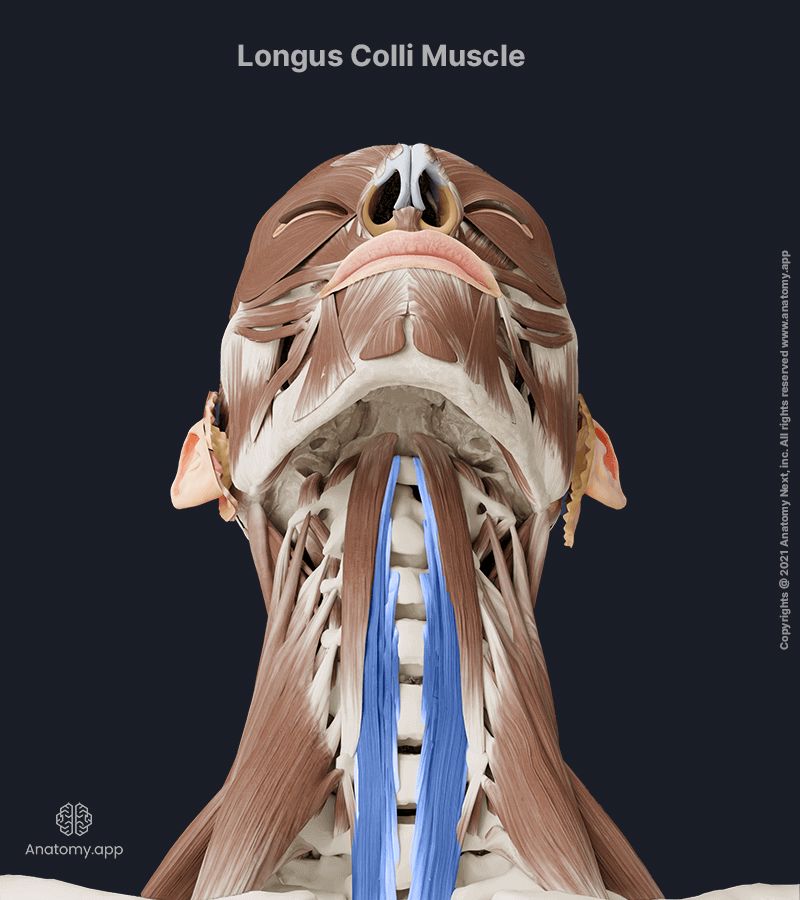- Anatomical terminology
- Skeletal system
- Joints
- Muscles
- Head muscles
-
Neck muscles
- Superficial neck muscles
- Scalene muscles
- Suprahyoid muscles
- Infrahyoid muscles
- Prevertebral muscles
- Suboccipital muscles
- Muscles of upper limb
- Thoracic muscles
- Muscles of back
- Muscles of lower limb
- Heart
- Blood vessels
- Lymphatic system
- Nervous system
- Respiratory system
- Digestive system
- Urinary system
- Female reproductive system
- Male reproductive system
- Endocrine glands
- Eye
- Ear
Longus colli
The longus colli (Latin: musculus longus colli) is a long and thin paired deep muscle of the neck. It stretches anterior to the vertebral column between the atlas and thoracic vertebrae. The longus colli is one of the prevertebral muscles covered by the prevertebral layer of the cervical fascia. It also belongs to the anterior neck muscles. The longus colli provides the flexion and rotation of the neck. This muscle is composed of three parts - superior (upper) oblique, vertical intermediate (central) and inferior (lower) oblique. All parts have different origin and insertion sites.
| Longus colli | |
| Origin | Superior oblique part - anterior tubercles of transverse processes of C3 - C5 vertebrae Vertical intermediate part - anterior surfaces of C5 - T3 vertebral bodies Inferior oblique part - anterior surfaces of T1 - T3 vertebral bodies |
| Insertion | Superior oblique part - anterior tubercle of atlas (C1) Vertical intermediate part - anterior surfaces of C2 - C4 vertebral bodies Inferior oblique part - anterior tubercles of transverse processes of C5 - C6 vertebrae |
| Action | Unilateral contractions - neck lateral flexion (ipsilateral), neck rotation (contralateral) Bilateral contractions - neck flexion |
| Innervation | Anterior rami of 2nd to 6th cervical spinal nerves (C2 - C6) |
| Blood supply | Branches of vertebral, ascending pharyngeal and inferior thyroid arteries |
Origin
The superior oblique part of the longus colli muscle originates from the anterior tubercles of the transverse processes of the 3rd to 5th cervical vertebrae (C3 - C5), the vertical intermediate part from the anterior surfaces of the bodies of the 5th cervical vertebra to the 3rd thoracic vertebra (C5 - T3), and the inferior oblique part originates from the anterior surfaces of the bodies of the 1st to 3rd thoracic vertebrae (T1 - T3).

Insertion
The superior oblique part of the longus colli inserts on the anterior tubercle of the atlas (C1), the vertical intermediate part on the anterior surfaces of the bodies of the 2nd to 4th cervical vertebrae (C2 - C4), and the inferior oblique part inserts on the anterior tubercles of the transverse processes of the 5th to 6th cervical vertebrae (C5 - C6).
Action
By contracting on both sides, the longus colli muscle flexes the neck. By contracting on one side, it provides the lateral flexion of the neck (ipsilateral) and neck rotation (contralateral).
Innervation
The longus colli is innervated by the branches of the anterior rami of the 2nd to 6th cervical spinal nerves (C2 - C6).
Blood supply
The longus colli muscle receives arterial blood supply from the branches of the ascending pharyngeal, vertebral and inferior thyroid arteries.